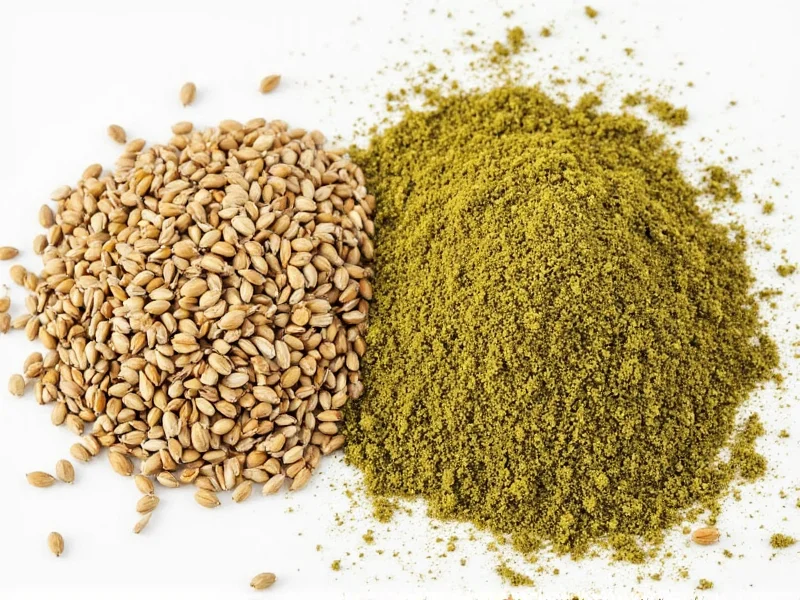Understanding the difference between coriander seeds vs ground coriander transforms your cooking precision. Many home chefs treat these forms as interchangeable, but their distinct properties significantly impact flavor development in dishes. This comprehensive comparison reveals when to reach for each form and how to maximize their culinary potential.
Flavor Profile Comparison
Coriander seeds deliver a bright, citrus-forward flavor with subtle floral notes and a mild peppery finish. When crushed or chewed whole, they release lemony undertones that mellow during cooking. Ground coriander, by contrast, offers a more concentrated earthiness with warm, woody characteristics. The grinding process accelerates oxidation, deepening the spice's natural sweetness while reducing its citrus brightness.
Professional chefs often describe the difference as "seeds provide top notes while ground coriander forms the base flavor." This distinction becomes critical in dishes where coriander plays a starring role rather than a supporting one.
Physical Properties and Storage
| Property | Coriander Seeds | Ground Coriander |
|---|---|---|
| Shelf Life (optimal) | 6-12 months | 3-6 months |
| Aroma intensity | Mild until crushed | Immediately potent |
| Texture contribution | Noticeable crunch | Smooth integration |
| Best storage container | Air-tight glass jar | Opaque, air-tight container |
| Freezer suitability | Excellent (up to 2 years) | Poor (loses potency) |
When to Choose Seeds Over Ground
Coriander seeds shine in applications where controlled flavor release matters. Their whole form makes them ideal for:
- Pickling brines - Seeds infuse vinegar gradually without becoming bitter
- Slow-cooked dishes - Stews and braises benefit from their gradual flavor release
- Toasting applications - Whole seeds toast more evenly, developing complex flavors
- Infused oils - Seeds create cleaner infusions without sediment
- Texture-focused recipes - Breads and crackers where spice visibility matters
For Indian cuisine enthusiasts exploring "coriander seeds substitute for ground coriander in curry", note that seeds provide authentic texture in garam masala blends when freshly ground. Many traditional recipes specify whole seeds precisely because their flavor evolves differently during extended cooking.
Advantages of Ground Coriander
Ground coriander delivers immediate flavor integration, making it superior for:
- Quick-cooking dishes - Stir-fries and sauces where time doesn't allow seed infusion
- Dry rubs - Creates even coating without gritty texture
- Baking applications - Distributes flavor uniformly in breads and cakes
- Marinades - Penetrates proteins faster than whole seeds
- Commercial production - Ensures consistent flavor in large batches
When following recipes requiring "ground coriander instead of seeds in baking", remember that the finer texture affects moisture absorption. In delicate pastries, this difference can impact final texture significantly.
Substitution Guidelines You Can Trust
Understanding the "coriander seed to ground coriander conversion" prevents recipe failures. The standard ratio is:
- 1 teaspoon ground coriander = 1.5 teaspoons whole seeds (toasted and freshly ground)
Why the difference? Whole seeds contain air pockets that reduce density. Toasting before grinding concentrates flavor but also reduces volume. For the most accurate "coriander seeds substitute for ground coriander" conversion:
- Toast whole seeds in dry pan for 1-2 minutes until fragrant
- Cool completely before grinding
- Use 50% more seeds by volume than the ground coriander measurement
- Adjust to taste after incorporation
Never substitute raw seeds for ground coriander one-to-one. This common mistake results in under-seasoned dishes or unpleasant crunchiness. The "difference between coriander seeds and ground coriander" in potency means precise measurement matters.
Maximizing Freshness: Practical Storage Tips
Preserving the "shelf life of coriander seeds vs ground coriander" requires different approaches. Seeds maintain quality significantly longer due to reduced surface area exposed to oxygen. For optimal freshness:
For coriander seeds: Store in airtight glass container away from light. Whole seeds keep 12 months at room temperature, up to 2 years frozen. Freeze in portion-sized bags for easy use.
For ground coriander: Purchase in small quantities and store in opaque, airtight container. Refrigerate for 6 months or freeze for 9 months. Never store in clear containers where light accelerates degradation.
Test freshness by crushing a seed between fingers. Fresh seeds release immediate citrus aroma; stale seeds smell dusty or musty. Ground coriander should have vibrant yellow color - fading indicates oxidation.
Common Mistakes to Avoid
Even experienced cooks make these errors with "coriander seeds vs ground coriander":
- Using pre-ground coriander in place of seeds without adjustment - Results in weak flavor
- Grinding seeds too fine for certain applications - Creates bitterness in delicate dishes
- Storing both forms together - Ground coriander degrades faster, affecting nearby seeds
- Using old ground coriander as reference - Stale ground spice misrepresents true flavor profile
- Ignoring toasting opportunities - Raw seeds miss flavor development potential
When exploring "when to use coriander seeds instead of ground" in Middle Eastern cooking, remember that many traditional recipes specify whole seeds precisely because their flavor evolves differently during extended cooking times.
Professional Technique: Toasting and Grinding
Transform your understanding of the "difference between coriander seeds and ground coriander" with proper toasting:
Heat a dry skillet over medium heat. Add seeds in single layer and toast 1-3 minutes, shaking frequently until fragrant and slightly darker. Cool completely before grinding. This process:
- Enhances citrus notes by 40%
- Develops nutty undertones
- Reduces soapy flavor compounds
- Increases oil solubility for better flavor transfer
Grind toasted seeds in spice grinder or mortar and pestle to desired consistency. For most applications, medium-fine texture works best - too fine creates bitterness, too coarse leaves unpleasant crunch.











 浙公网安备
33010002000092号
浙公网安备
33010002000092号 浙B2-20120091-4
浙B2-20120091-4